Dicentra canadensis
Native, slightly fragrant spring ephemeral bearing heart-shaped flowers
Dicentra canadensis squirrel corn
This delicate native perennial is similar to Dutchman’s breeches (D. cucullaria) and is often mistaken for that related species. Both plants belong to the Papaveraceae family. Both are spring ephemeral plants that bloom early and die back by midsummer. Squirrel corn normally blooms about one week later than Dutchman’s breeches, but often they are in the flowering stage at the same time.
The flowers of squirrel corn are also more heart-shaped than those of Dutchman's breeches and lack the lower yellow tip of Dutchman’s breeches. The two upper spurs (at the stalk base of the flower) are also shorter and more rounded than those of D. cucullaria. At the top (visually lower than the base) of the flower is a pair of small lobes (part of outer petals) that open like wings to reveal the short stamens and a stigma. A pair of long, vertical ruffles (part of inner petals) are at right angles to the wings. Squirrel corn is also slightly fragrant, having a scent similar to the hyacinth.
Both squirrel corn and Dutchman’s breeches grow in rich hardwood forests. Squirrel corn has a shape similar to the wild bleedingheart (D. eximia) but does not have the pink or red coloration, though it may have a faint lavender or pink tint. The flowers grow in clusters of 3 to 10, hanging from a smooth stem held above the leaves. Most colonies of squirrel corn are found on north-facing slopes.
Its common name comes from the underground tubers that resemble grains of yellow corn. Mice and chipmunks are adept at transplanting the tubers and helping spread the plant. Ants also help distribute the seeds, rewarded by a nutritious elaisome appendage.
The one or two basal leaves are compound with three leaflets and much divided. Squirrel corn is pollinated by bumblebees and has nectar stolen by bees that bite through the flower membrane. Squirrelcorn grows to a height of 6-11 inches and is found throughout northeastern and north-central United States. Both squirrel corn and Dutchman’s breeches are poisonous to grazing cattle but seldom grow where they graze. Squirrel corn has become rare and threatened in some states.
Habitat & Range
Frequent in moist, rich woods. Prefers part-shade to shade and moist, humus-rich, well-drained soil.
Present throughout the state.
Range: Found throughout northeastern and northcentral United States.
Wetland code: Not classified
Phenology
Flowers April through May. Blooming period is 2 to 3 weeks.
Characteristics
Inflorescence raceme; 3-10 hanging flowers
Flowers elongated heart-shaped, white or cream-colored; 2 outer fused petal & 2 inner fused petals; ½ - ¾″ long; pedicels nodding, pale green/reddish-green, glabrous, up to ¼" long
outer petals have 2 rounded nectar spurs at base of corolla & 2 reflexed lips (shaped like wings) at the top (base is visually above the top)
inner petals form a pair of long lateral ruffles and a pair of small lips in the shape of keeled hoods
Leaves basal, twice compound, 1 or 2 per flowering stem; somewhat glaucous, 4-11″ long. Each blade is divided into 3 highly dissected leaflets, each leaflet may further divide into 3 subleaflets.
Stem (scape) glabrous, green to green-brownish; up to 11 inches long
Fruit slender capsule; 0.6″ long; seeds very glossy black, kidney-shaped, abt 2.6mm long, aril pale & wing-like
Height 7-11 inches
Plant Codes
S-rank: No rank
G-rank: G5 (Secure)
Ecology
Main pollinators are bumblebees. Mice, chipmunks and squirrels dig up the tubers and move them to new locations helping the plant spread.
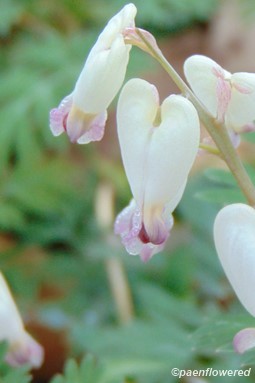
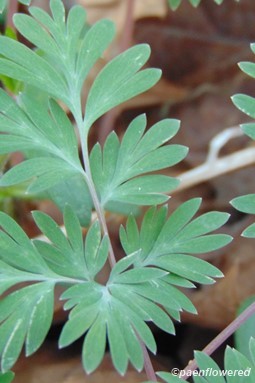
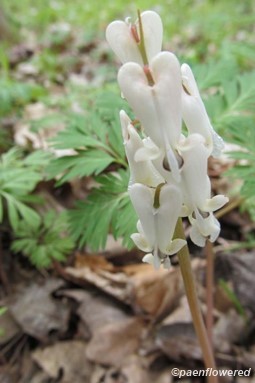
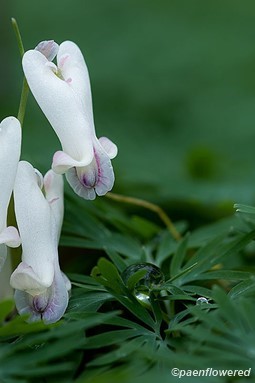
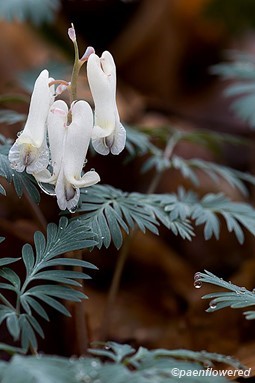




Comments
Have you spotted this plant in your area? We'd love to hear about your experience! Share your comments or questions about the plant below. Comments are moderated before posting.